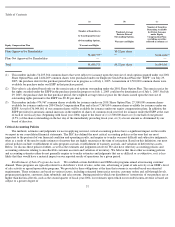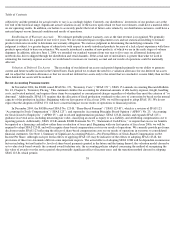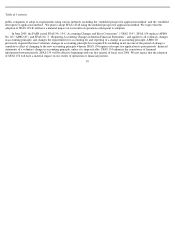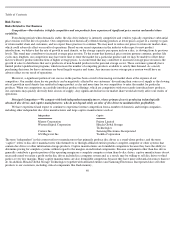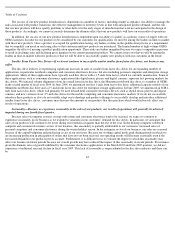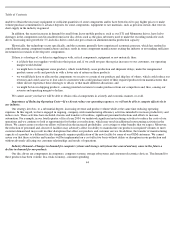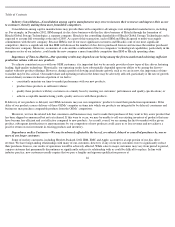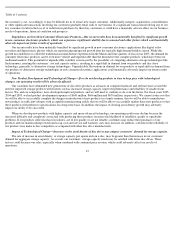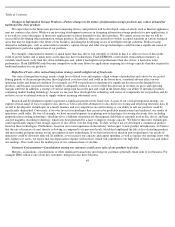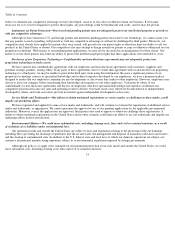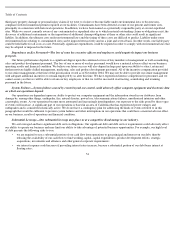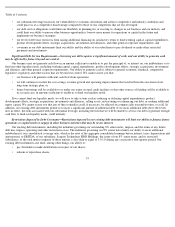Seagate 2004 Annual Report Download - page 48
Download and view the complete annual report
Please find page 48 of the 2004 Seagate annual report below. You can navigate through the pages in the report by either clicking on the pages listed below, or by using the keyword search tool below to find specific information within the annual report.
Table of Contents
tends to decline and retail demand for personal computers and consumer electronics devices tends to decrease, as does enterprise demand for
computer systems and storage subsystems. During economic slowdowns such as the one that began in 2000, demand for disc drives,
particularly in the enterprise sector was adversely impacted as a result of the weakened economy and because enterprises shifted their focus
from making new equipment purchases to more efficiently using their existing information technology infrastructure through, among other
things, adopting new storage architectures. Unexpected slowdowns in demand for computer systems and storage subsystems generally cause
sharp declines in demand for disc drive products.
Additional causes of declines in demand for our products in the past have included announcements or introductions of major operating
system or semiconductor improvements or changes in consumer preferences, such as the shift from desktop to notebook computers. We believe
these announcements and introductions have from time to time caused consumers to defer their purchases and made inventory obsolete.
Whenever an oversupply of disc drives causes participants in our industry to have higher than anticipated inventory levels, we experience even
more intense price competition from other disc drive manufacturers than usual.
Dependence on Distributors—We are dependent on sales to distributors, which may increase price erosion and the volatility of our
sales.
A substantial portion of our sales has been to distributors of desktop disc drive products. Product qualification programs in this
distribution channel are limited, which increases the number of competing products that are available to satisfy demand, particularly in times of
lengthening product cycles. As a result, purchasing decisions in this channel are based largely on price, terms and product availability. Sales
volumes through this channel are also less predictable and subject to greater volatility than sales to our OEM customers. In the second half of
fiscal year 2004, a number of disc drive manufacturers independently launched initiatives to improve the stability of the distribution channel,
particularly with respect to the purchasing behavior of these distributors while other disc drive manufacturers have not. These actions have
further increased the uncertainty as to demand within this market segment. To the extent that distributors reduce their purchases of our products
or prices decline significantly in the distribution channel, our results of operations would be adversely affected.
Longer Product Life Cycles—Lengthening of product life cycles can make planning product transitions difficult and may reduce the
favorable impact of new product transitions.
In contrast to historical trends, based on our recent experience in the industry with respect to new product introductions, we believe that
the current rate of growth in areal density is slowing from the rate of the last several years. We believe that this slowdown in the rate of growth
in areal density will continue until a significant advance in technology for the electronic storage of data, such as perpendicular recording
technology, becomes commercially available.
When the rate of growth in areal density slows, it may contribute to increased average price erosion to the extent historical price erosion
patterns continue, a limitation in our ability to introduce new products at higher prices and lengthened product life cycles which permits
competitors more time to enter the market for a particular type of disc drive. In addition, the lengthening of product life cycles can make
planning product transitions more difficult. To the extent that we prematurely discontinue a product, or do not timely introduce new products,
our operating results may be adversely affected.
Because the rate of growth in areal density is slowing, the favorable impact of new product introductions on our results of operations may
be minimized. Historically, the introduction of new products generally has had a favorable impact on our results of operations both because the
new products are introduced at higher prices than existing competitive offerings and because advances in areal density technology have enabled
lower manufacturing costs through a reduction in components such as read/write heads and discs. However, in contrast to when the rate of
growth in areal density is increasing, a slowing rate of growth in areal density can limit the cost benefits of new products because it is
technologically more difficult to reduce the number of read/write heads and discs in a particular drive. In addition, given the environment of
intense price competition, in the absence of significant capacity or reliability increases, it is difficult to obtain higher prices for new products.
45




